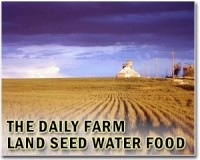 |
Washington DC (SPX) Apr 13, 2010 Nations of the Greater Mekong Subregion need to 'rethink' their agricultural industries to meet future food needs, given the social shifts and climate changes that are forecast for the coming decades. With better farming practices, and by managing agriculture within the wider context of natural ecosystems, nations could boost production and increase the wealth and resilience of poor people in rural communities. Demand for food is forecast to double by 2050, as populations swell and people's dietary choices change. If governments act now, they will be better placed to meet this target and withstand the more severe climatic changes likely to affect the GMS beyond 2050. These are the main messages of the summary report Rethinking Agriculture in the Greater Mekong Subregion: How to Sustainably Meet Food Needs, Enhance Ecosystem Services and Cope with Climate Change, published by IWMI in cooperation with the Swedish International Development Cooperation Agency (Sida) and the WorldFish Center. The report assesses the environmental, social and agricultural characteristics of the GMS nations, analyses the future drivers of agricultural change in the region - from global trade and regulatory pressures to urbanization and climate change - and outlines the changes that must be made if future food demands are to be met. "Over the past 20 years, all the GMS countries have considerably increased their agricultural production," explained Andrew Noble, IWMI's Regional Director for SE Asia, and one of the authors of the report. "However, this has come at a heavy cost to the environment and without significantly decreasing poverty in large areas of the region. Technologies and practices already exist that can help farmers use water more efficiently, increase crops yields further and adapt to changing climatic conditions. "Farmers will be much more successful at producing food if degraded environments are restored and if rural households have enough money to invest in the water storage facilities and soil improvements needed to prevent crop failure in the event of droughts and floods." Sustainably producing food for the world's growing population undoubtedly remains the overwhelming priority for agriculture. With land already at a premium, increasing productivity from existing land, cutting post-harvest losses and reducing food waste will be key. Scientists are continually developing solutions to increase agricultural productivity without further damaging the environment. These include improving crop, livestock and cultured fish varieties, using water more efficiently in irrigated and rain-fed farming and employing more ecosystem-friendly agricultural methods. Relatively simple, low-cost changes could result in large increases in productivity if applied appropriately. However, nations will need to shift their focus from simply raising yields at field level to optimising productivity across the whole landscape. Better management of wetlands and rivers for both fisheries and agriculture is essential, especially as poor rural communities rely on fish for 'free' protein and their livelihoods. Cutting post-harvest losses, estimated to be between 10 and 40%, could add to food supplies and reduce the level of intensification required to provide sufficient food. Agricultural production too often comes at the cost of natural ecosystem functions. For example, deforestation reduces an ecosystem's ability to regulate soil erosion; eradicating wetlands prevents streams from regulating floods and destroys fish habitats; and clearing mangroves weakens shoreline protection from storms. Using the technology available today, it is possible to modify agricultural landscapes to minimize, even reverse negative impacts and enhance the function of natural ecosystems. Improving the livelihoods of small-scale fishers and farmers who constitute the majority of rural producers is the simplest, cheapest and fastest way of building resilience into agricultural systems. Governments can help by rethinking ways to secure land and water rights, diversify production to reduce wholesale crop failure, and provide financial safety nets.
Share This Article With Planet Earth
Related Links International Water Management Institute Farming Today - Suppliers and Technology
 Japanese robo-suit promises superpowers for greying farmers
Japanese robo-suit promises superpowers for greying farmersTokyo (AFP) April 9, 2010 While Robocop and Iron Man can dodge bullets and crush villains, a new powered suit from Japan promises its elderly users more modest powers, such as pulling up radishes without getting a backache. Unlike its heavily-armed Hollywood counterparts, the Power Assist Suit aims to make life easier for Japan's army of greying farmers. The metal-and-plastic exoskeleton boasts eight electric mot ... read more |
|
| The content herein, unless otherwise known to be public domain, are Copyright 1995-2010 - SpaceDaily. AFP and UPI Wire Stories are copyright Agence France-Presse and United Press International. ESA Portal Reports are copyright European Space Agency. All NASA sourced material is public domain. Additional copyrights may apply in whole or part to other bona fide parties. Advertising does not imply endorsement,agreement or approval of any opinions, statements or information provided by SpaceDaily on any Web page published or hosted by SpaceDaily. Privacy Statement |